This lovely specimen of Oncorhynchus nerka, a Pleistocene Sockeye Salmon, is from outcrops along the South Fork Skokomish River, Olympic Peninsula, Washington State, USA.I'd expected to learn that the locality contained a single or just a few partial specimens, but the fossils beds are abundant with large, 45–70 cm, four-year-old adult salmon concentrated in a beautiful sequence of death assemblages.
The specimens include individuals with enlarged breeding teeth and worn caudal fins. It is likely that these salmon acted very similar to their modern counterparts with males partaking in…
Paleontology
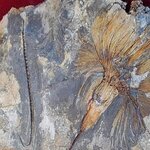
This exceptionally well-preserved crinoid, Delgadocrinus oportovinum, was found on October 11, 1905, by Nery Delgado during his work mapping the geology and paleontology of Portugal.
Crinoids are marine animals in the class Crinoidea. They are echinoderms related to starfish, sea urchins, sea cucumbers and brittle stars. Adult crinoids have a mouth located on the upper surface surrounded by feeding arms. These have feathery pinnules and are spread wide to gather planktonic particles from the water.
Delgado's find resulted in the creation of a new family, Delgadocrinoinidae, a new…

Ferguson Hill contains the most complete macrofossil record spanning the Triassic-Jurassic boundary in North America. The ammonoids from the uppermost Triassic can be traced to the boundary and the earliest ammonites (Psiloceratids) can be seen right at the base of the Jurassic.It was in contention for the Global Stratotype Section and Point (GSSP) defining the base of the Jurassic System, Lower Jurassic Series and Hettangian Stage. However, in 2008, the Kuhjoch (Karwendel Mountains, Northern Calcareous Alps, Tyrol, Austria) was chosen over Ferguson Hill mainly because the beds containing the…

The festive lassie you see here is an Anglerfish. They always look to be celebrating a birthday of some kind, albeit solo. This party is happening deep in our oceans right now. The wee candle you see on her forehead is a photophore, a tiny bit of luminous dorsal spine. In anglerfish' world, it's highly alluring. The photophore is an adaptation used to attract prey and mates alike.
Deep in the murky depths of the Atlantic and Antarctic oceans, hopeful female anglerfish light up their sexy lures. When a male latches onto this tasty bit of flesh, he fuses himself totally. He might be one of…
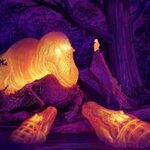
Scientists believe two large holes in the roof of a T. rex's skull, called the dorsotemporal fenestra, were filled with muscles that assist with jaw movements.
But Casey Holliday, a professor of anatomy at University of Missouri-Columbia, didn't think that made much sense. "It's really weird for a muscle to come up from the jaw, make a 90-degree turn, and go along the roof of the skull. Yet, we now have a lot of compelling evidence for blood vessels in this area, based on our work with alligators and other reptiles."
For a new study, Holliday and colleagues used thermal imaging to…
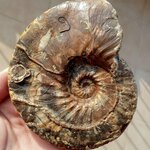
A beautiful specimen of the ammonite, Anahoplites planus (Mantell, 1822) from Albian deposits in Courcelles-sur-Voire, Aube, north-central France. Anahoplites (Sowerby, 1815) is a genus of compressed hoplitid ammonites with flat sides, narrow, flat or grooved venters, and flexious ribs or striae arising from weak umbilical tubercles that end in fine dense ventrolateral nodes.
Anahoplites is now included in the subfamily Anahoplitinae and separated from the more robust Hoplitinae. Genera of the Hoplitinae tend to have broader whorls and stronger ribs.
Anahoplites is found in Cretaceous (Middle…
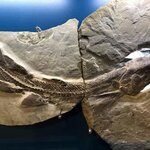
An exquisite fossil specimen of an Eusthenopteron Fordi from the upper Devonian (Frasnian), Eescuminac Formation, Miguasha Park, Bay of Heat, Gaspé, Quebec, Canadian Museum of Natural History, Miguasha Collection.
If you look closely at this specimen, you can see the remarkable 3-D and soft-bodied preservation. This fish specimen reminds me of the ray-finned fossil fish you see in carbonate concretion from Lower Cretaceous deposits in the Santana Formation, Brazil.
Eusthenopteron would have shared our ancient seas with the first ammonites and primitive sharks, along with well-established…

This fossil specimen of the fruit of the lotus, Nelumbo, was found by Green River Stone (GRS) in early Eocene outcrops of the Fossil Lake Member of the Green River Formation. The awesome possums from GRS are based out of North Logan, Utah, USA and have unearthed some world-class specimens. They've found Nelumbo leaves over the years but this is their first fossil specimen of the fruit.
The spectacularly preserved fruit was found in 2018 and measures 6-1/2" round. Here you can see both the part and counterpart in fine detail. There is another spectacular specimen from Fossil Butte…
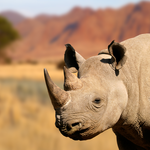
The Miocene pillow basalts from the Lake Roosevelt National Recreation Area of central Washington hold an unlikely fossil mold of a small rhinoceros, preserved by sheer chance as it's bloated carcass sunk to the bottom of a shallow pool or lake just prior to a volcanic explosion. We've known about this gem for a long while now. The fossil was discovered by hikers back in 1935 and later cast by University of California paleontologists in 1948. These were the Dirty Thirties and those living in Washington state were experiencing the Great Depression along with the rest of the country and…

Quintus Sertorius, a Roman statesman come general, grew up in Umbria, the green heart of what is now central Italy.
Born into a world at war just two years before the Romans sacked Corinth to bring Greece under Roman rule, Quintus lived much of his life as a military man far from the hills, mountains, and valleys of his birthplace. In 81 BC, he traveled to Morocco, the land of opium, massive trilobites and the birthplace of Antaeus, the legendary North African ogre who was killed by the Greek hero Heracles.
The locals tell a tale that Quintus requested proof of Antaeus, hard evidence he…
